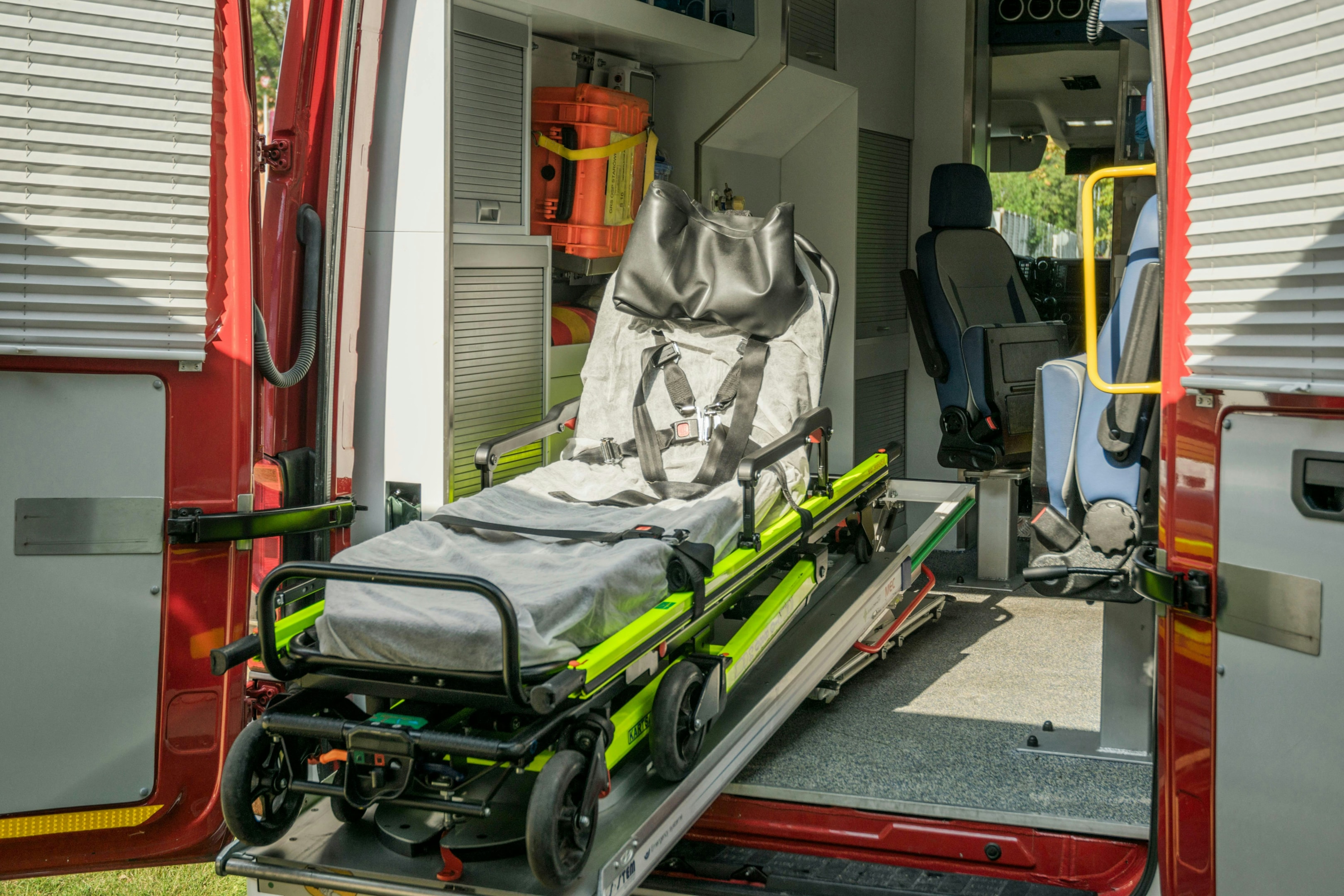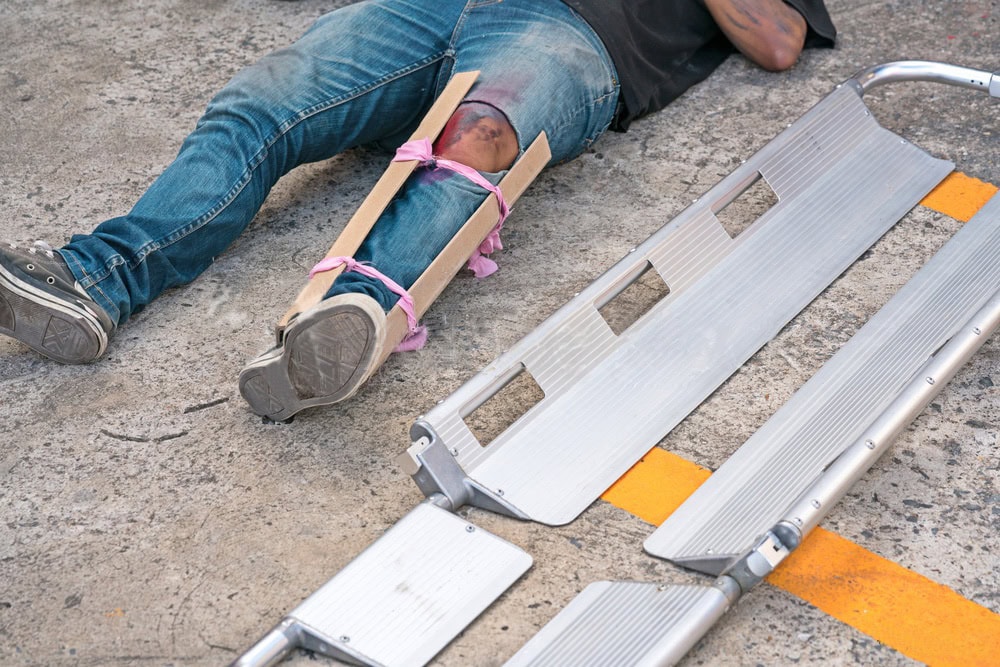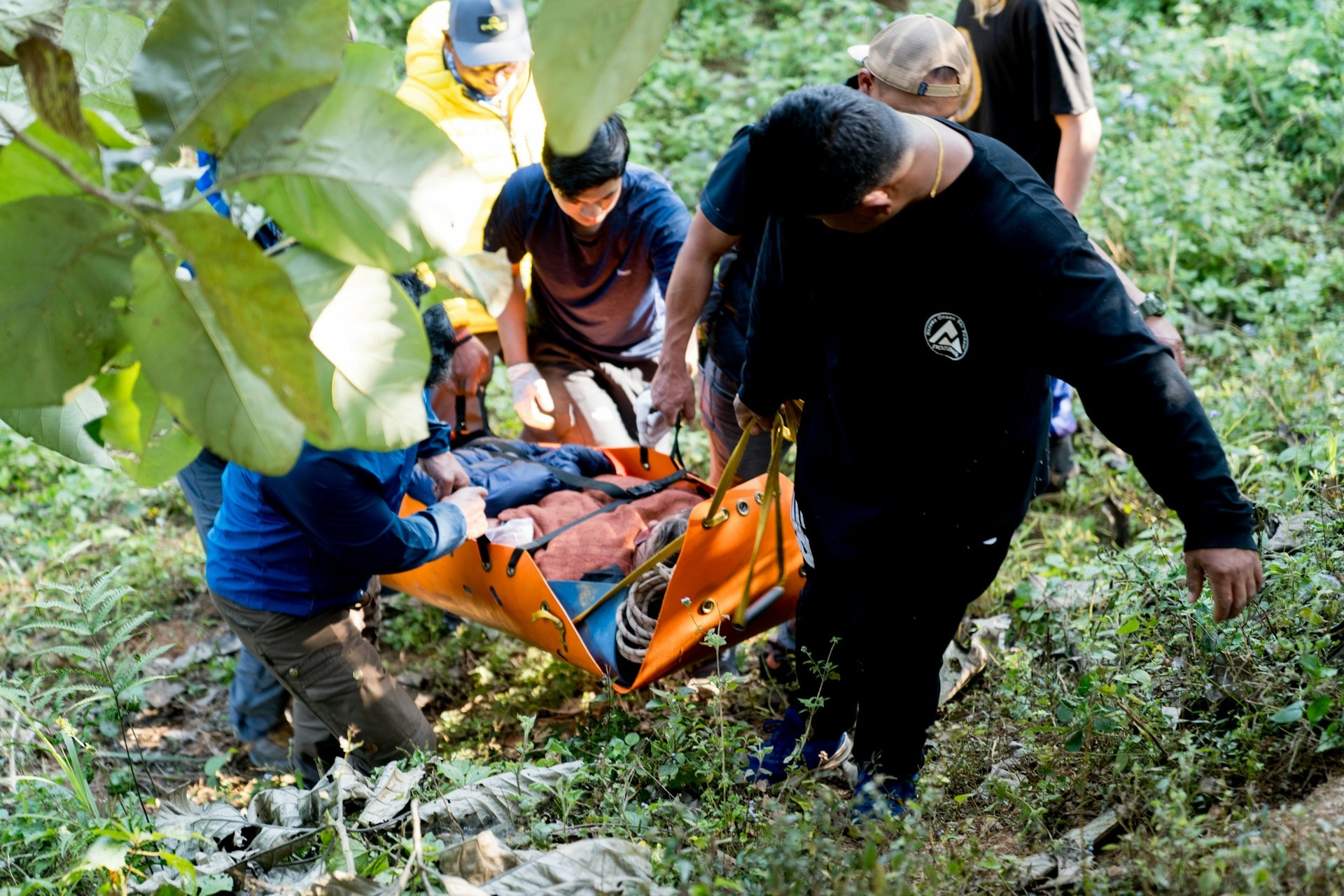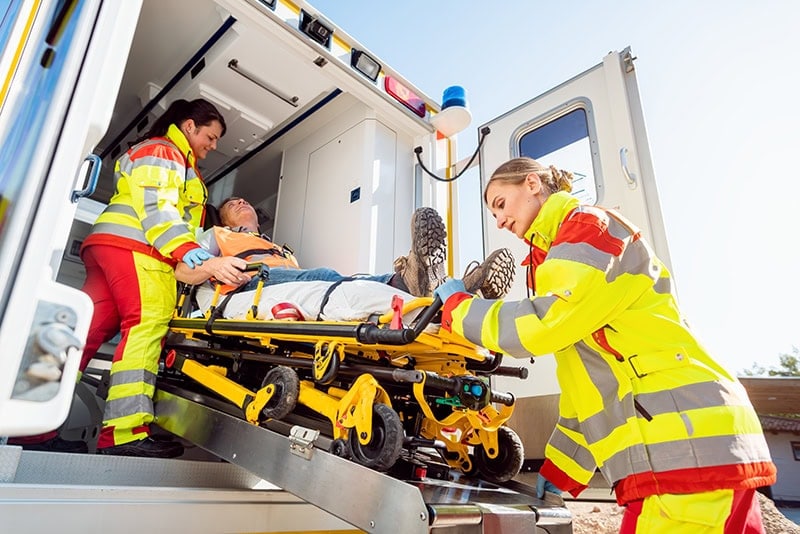A stretcher services two goals: transfer the patient smoothly (i.e. keep them strapped down, no bumps in transit), and keep the patient comfortable. The wrong kind could leave you and the patient in a very dangerous position.
Whether you’re a hospital professional, a paramedic on call, or just someone curious about what is a stretcher and how it keeps patients safe, you’re in the right place. This guide will walk you through every type, key considerations for purchasing, and essential maintenance tips.
We’ll talk about weight capacity, storage, and even features that accommodate your team’s needs. That way you can make an informed decision that balances safety, cost-effectiveness, and functionality.
Types of Stretchers
Ambulance Stretcher
Designed specifically for ambulances, they are used to transfer patients from accident scenes to hospitals. They are typically made from sturdy, lightweight, and adjustable materials to ensure patient stability and comfort during transport. You can see them with features like collapsible legs for loading into ambulances.
Best Used For: Emergency response teams, ambulance services.

Scoop Stretcher
Scoop stretchers consist of two rigid panels that can be positioned under the patient like a “scoop,” making them ideal for quick transfers. They excel in situations where the patient must remain immobile, such as on uneven terrain or tight spaces.
Best Used For: Trauma patients, difficult access areas.

Folding Stretcher
A folding or portable stretcher is most beneficial when they are highly portable and designed for rapid deployment. They can be folded for easy storage, making them perfect for emergency situations or environments with limited space.
Best Used For: Disaster response, field rescues, temporary setups.
Stair Stretcher
Specially crafted for staircases or confined areas, stair stretchers often feature wheels, tracks, or slide systems to enable smooth patient movement up or down stairs. They are lightweight yet sturdy, ensuring both patient safety and caregiver control.
Best Used For: Multi-story buildings, rescue operations in tight spaces.
Multi-Function Rescue Stretcher
Multi-function stretchers are versatile, featuring adjustable head and leg supports. They cater to a variety of emergency situations, providing flexible positioning for patient comfort and medical access.
Best Used For: Multi-scenario rescues, hospital emergencies.

Vacuum Stretcher
A vacuum stretcher molds to the patient’s body by removing air, forming a supportive structure. This design ensures immobilization and protection, especially for patients with spinal injuries or fractures.
Best Used For: Trauma care, spinal injuries.

Robertson Stretcher
Ideal for severely injured patients, Robertson stretchers come with advanced strap and fastening systems that provide maximum stability during transport. These are particularly useful in ensuring patients with fractures or critical injuries remain secure.
Best Used For: Spinal and critical trauma cases.
Selecting the Right Stretcher for Your Patients
You’re searching for a patient stretcher that ticks all the boxes—durability, comfort, and practicality.
- Type of Patient: Are you dealing with bariatric patients, trauma victims, or critically ill individuals? Each kind of stretcher has features to accommodate those specific needs.
- Mode of Transport: Will the patient be transported in an ambulance, moved across a hospital floor, or airlifted? Different stretchers are suited for different environments.
- Weight Capacity: Don’t take chances here. Choose a device with the appropriate weight capacity to handle the load of heavier patients safely.
- Environment and Terrain: Are you navigating uneven surfaces, tight spaces, or stairs? A stretcher with adjustable legs and a sturdy base is a lifesaver for paramedics and first responders.
- Caregiver Needs: A lightweight stretcher that adjusts for height and position makes it easier to load, carry, and maneuver the injured, sick, or strapped patients.
- Patient Safety: Safety is non-negotiable. Look for secure restraints, safety rails, and a stable cot to keep the patient protected during transport.
- Storage and Accessibility: A stretcher that can be stored easily and found quickly when needed saves valuable time.

Stretcher Features and Accessories
To maximize functionality and safety, consider the following features and accessories when purchasing a stretcher:
- Adjustable Height: Enables easy loading and unloading while reducing caregiver strain.
- Canvas or Bed Surfaces: Prioritize stretchers with comfortable and durable surfaces for patient well-being.
- Restraints and Safety Straps: Essential for keeping patients secure during transport.
- Portability and Storage: Portable stretchers save space and are easy to deploy in emergencies.
- Accessories: Add-ons like IV poles, oxygen tank holders, and head immobilizers enhance stretcher versatility.
5 Guidelines for Carrying a Patient on a Stretcher
1. Get The Right Type of Stretcher
First things first—know your tools. Do you need a lightweight canvas stretcher for rough terrain? Or a sturdy cot for hospital transport? There’s even a helicopter-friendly type designed for aerial patient transport.
2. Position Matters
The patient’s safety depends on how well they’re strapped and supported.
- Flat Back for Stability: Keep the patient’s back flat unless otherwise required.
- Legs and Arms: Adjust the position so their limbs are stable and won’t dangle.
- Head Placement: Ensure the patient’s head is secured to face upward—especially if the stretcher moves.
Strap them in snug but comfortable. Loose straps are a physical risk. Tight straps cause discomfort.
3. Teamwork Makes the Transport Work
When using stretchers as a team, it’s crucial to adopt a coordinated and structured approach to ensure the patient’s safety and comfort while optimizing transport efficiency. Here are some tips for effective collaboration:
- Preparation and Planning: Before starting the transport, the team should meet to define roles and ensure everyone knows the procedures. This includes selecting the appropriate stretcher based on the patient’s needs (e.g., rigid stretcher for severe injuries or folding stretcher for quick transport).
- Clear Communication: Communication among team members is crucial to avoid mistakes. Use clear signals and simple verbal commands to coordinate movements, especially when lifting and moving the patient. Each member should know when to lift, turn, or lower the stretcher.
- Proper Positioning: During transport, it is important for the team members to be evenly distributed on each side of the stretcher. Each person should support the stretcher securely without compromising balance or stability. Lifting should be done using proper ergonomic techniques to avoid injury.
- Following Safety Protocols: The team should be trained in best safety and care practices. Stretchers should be equipped with securing devices to keep the patient in place. During the handling of the stretcher, make sure the patient remains comfortable, and their condition is monitored regularly.
- Task Distribution: Depending on the conditions and needs of the patient, some teams may be responsible for transporting the stretcher to a care unit, while others will focus on maintaining the patient’s stability during the transfer.
4. Adapt to the Environment
Every transport situation is unique, and you’ll need to adapt to what’s around.
- Hospitals and Ambulances: Smooth sailing. Just watch doorways and tight corners.
- Outdoors: Uneven surfaces need a stretcher with a stable base and firm grip.
- Helicopters: Be ready to secure the stretcher tightly before loading it. Turbulence and chaos don’t mix well with patients.
5. Know Your Limits (And the Stretcher’s Too)
Every type of stretcher has a weight capacity. Exceed it, and the whole transport process gets risky. If the load is too much, search for alternative methods or equipment that can accommodate the patient.
Maintenance and Safety Precautions for Stretchers
- Regular Inspections: Check for wear, damage, or malfunctioning parts, including wheels, frames, and straps.
- Cleaning and Disinfection: Follow manufacturer protocols for sterilizing stretchers after each use to ensure hygiene and prevent cross-contamination.
- Proper Storage: Store stretchers securely when not in use to prevent damage.
- Staff Training: Ensure all caregivers are trained in proper stretcher usage, including patient lifting techniques.
- Restraint Checks: Regularly test safety straps and fasteners to confirm they are secure and fully functional.
Top Stretcher Brands and Their Offerings
Stryker is a globally recognized leader in medical technology, renowned for delivering innovative, reliable, and user-friendly stretchers. Their Emergency Patient Transport line is designed with a focus on safety, ergonomics, and operational efficiency for EMS providers and hospitals.
Stryker products come with an ergonomic design that minimizes physical strain on caregivers with powered systems. The fasteners, automated controls, and enhanced stability add to the safety of the products. They are designed for EMS providers, hospitals, and specialized transport teams handling bariatric and critical patients.
Jiekang Medical specializes in durable stretchers that you can customize to suit unique situations. They are lightweight for easy handling but tough enough to handle the pressure. All stretchers are CE and ISO-certified, come with a one-year warranty and you can sign a quality assurance agreement. If a quality issue arises, you get 100% compensation. Quick and professional responses are available for inquiries, and problems that arise are resolved within 12 hours.
For brands carrying out marketing, Jiekang Medical provides complete certifications and detailed product information to help you promote with ease. Their products are copyright-protected and ready for the market, helping you reduce upfront associated costs. Delivery is covered too. And if you’re wondering about delivery, we’ve got that covered, too. Jiekang ships to over 15 countries with fast delivery times—just 15 days.
Ferno is a global leader in pre-hospital emergency care and rescue solutions, known for its history of innovation and dedication to improving patient care and safety since 1955. With a presence in over 100 countries, Ferno combines decades of experience with cutting-edge designs to deliver robust and reliable products for EMS professionals, rescue teams, and hospitals.
Ferno come with a history of innovation, pioneering modern EMS equipment, including the revolutionary X-Frame Cot and iNTRAXX systems. Trusted across over 100 countries, the brand serves EMS, fire rescue, hospitals, and industrial safety sectors, complete with products like basket stretchers and edge management tools for complex rescues.
Medline is a leading global healthcare company that delivers comprehensive medical solutions, including a wide range of cost-effective and durable stretchers. Known for their focus on operational efficiency and clinical outcomes, Medline stretchers are designed to meet the needs of hospitals, surgical centers, and emergency care providers.
Medline offers more than 290 product options, ranging from soft stretchers to specialized transport solutions.: The brand high performance with cost-effective solutions, making quality equipment accessible for healthcare facilities of all sizes. And with over 50 distribution centers and 28 million square feet of warehousing space, Medline ensures timely delivery of critical equipment.
Let’s Find the Perfect Stretcher for You
Not sure which stretcher suits your needs? Let’s talk. Our experts are ready to provide tailored recommendations to help you make the best choice.
Contact us today for a consultation and get the right solution



